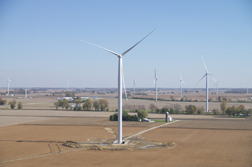Indiana wind developer sues over 1500ft setback, says zoning chair shouldn’t consider experience with existing wind farm
News, Wind turbines Add commentsOver the past several months, I’ve been watching with interest an apparently growing concern in farm country about wind farm setbacks. Several counties in Indiana and Illinois have been moving toward somewhat larger setback requirements after living with a first round of large-scale wind development.
This week, juwi Wind filed a suit challenging recent decisions by the Tipton County Board of Zoning Appeals, which in March approved a conditional use permit for the proposed Prairie Breeze Wind Farm, while requiring a 1500ft setback from non-participating property lines. The county zoning ordinance requires just 1000ft from non-participating homes, and in July, juwi requested that the permit conditions be changed to 1400ft from non-participating homes and 750ft from non-participating property lines. juwi claims that their request for this change was summarily rejected by the BZA without the required public hearing at which they could make their case. (Ed. note: It appears that the conditional use permit has no provisions for easements from landowners willing to live with turbines closer to their homes; the vast majority of turbine locations planned by juwi are closer than 1500ft from neighboring property lines.)
 In addition, juwi is making provocative claims that BZA chair Jerry Acres is no longer capable of making an unbiased decision, thanks to comments he’s made suggesting regrets about his support of the Wildcat Wind Farm (left), which began operating early this year and has generated complaints from at least 20 homeowners. At the March hearing at which the Prairie Breeze conditional use permit was approved, Acres said, “On the E.ON vote (approving the Wildcat Wind Farm), I looked more at the financial gains than probably the long-term losses. I probably didn’t do my homework on E.ON and that’s what I’m saying.” Acres also said at that meeting that he’s had some personal experience with siting issues, after visiting a friend who lives near Wildcat. This apparently straightforward response from a public official who is charged with understanding the consequences of his decisions is attacked by juwi; the complaint alleges that “these comments from the Board’s President, Acres, demonstrate that he was not unbiased and objective, and that he improperly injected his personal feelings into the matter, for whatever reason.”
In addition, juwi is making provocative claims that BZA chair Jerry Acres is no longer capable of making an unbiased decision, thanks to comments he’s made suggesting regrets about his support of the Wildcat Wind Farm (left), which began operating early this year and has generated complaints from at least 20 homeowners. At the March hearing at which the Prairie Breeze conditional use permit was approved, Acres said, “On the E.ON vote (approving the Wildcat Wind Farm), I looked more at the financial gains than probably the long-term losses. I probably didn’t do my homework on E.ON and that’s what I’m saying.” Acres also said at that meeting that he’s had some personal experience with siting issues, after visiting a friend who lives near Wildcat. This apparently straightforward response from a public official who is charged with understanding the consequences of his decisions is attacked by juwi; the complaint alleges that “these comments from the Board’s President, Acres, demonstrate that he was not unbiased and objective, and that he improperly injected his personal feelings into the matter, for whatever reason.”
Neighboring Howard County has settled on an increase from 1050ft to 1500ft from non-participating homes, along with a decrease in the noise limit from 55dB to 50dB, as Wildcat Wind Farm moves into Phase 2 and 3. Two other counties have enacted formal or informal bans on wind development; Marshall County formally banned wind farms, and Clinton County passed a non-binding motion to stay windfarm free. “I tell you, it’s not about money, it’s about people with me,” County Commission President Skip Evans said. “It’s about quality of life. It’s about all the citizens of Clinton County, not just those who stand to profit.”
Meanwhile, Delaware County has paused for two years, waiting to see how recent wind farm developments in the region work out before settling on a development plan. Tom Green, chair of the city-county plan commission, said in his proposal to pause, “I have noted many changes in policies around the country regarding this issue, some of those changes are a complete reversal of existing policy. Let us not make the same mistakes or reactions in providing guidance for our community.”
